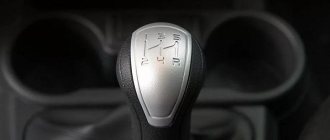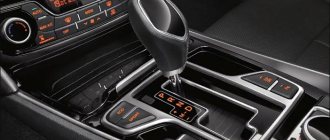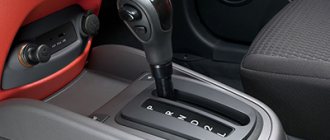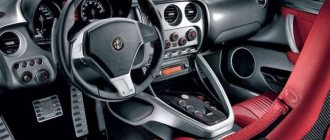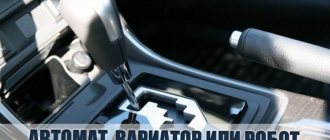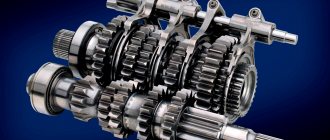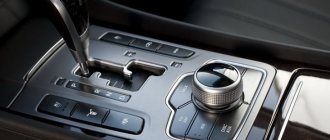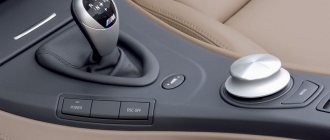The good old “mechanics” is gradually becoming a thing of the past, and in some countries it is already considered exotic; it has long been replaced by various automated gearboxes, allowing the driver not to think once again about which gear needs to be stuck in at the current moment. As a result of total automation and improvement of the gearbox, a completely new principle of gear shifting, the so-called “robot”, has recently appeared. And now we will look at what a robotic gearbox is, the pros and cons of such transmissions.
What is a robotic gearbox
What does a robotic gearbox mean? This is a part of a transmission, the design of which is no different from a manual gearbox, but is controlled using an automatic system that does not require driver intervention in the operation of the device. Due to the ability to operate fully automatically, manual transmissions are confused with automatic transmissions, although they have important design differences. Therefore, it is different how to use a robotic gearbox and how to use an automatic one.
There is also an external similarity between the two types of gearboxes: the car is not equipped with a gear shift lever, and there is also no third pedal - the clutch. Switching is carried out entirely without driver intervention.
How to distinguish an automatic machine from a robot visually
Experienced car owners and mechanics know well how to visually distinguish an automatic transmission from a robot.
Experts say that the selector lever will help determine externally what type of gearbox a car has. If you look at the automatic transmission, you can see the following rocker positions:
- “P” – parking;
- “N” – neutral;
- “R” – rear;
- "D" - forward movement.
The presence of other provisions depends on the machine model.
If you look at the robotic transmission, the car owner will see:
- “N” – neutral;
- “R” – rear;
- "D" - forward movement.
The “Parking” position may not be available in the robot.
But the robotic gearbox is not similar to an automatic transmission not only in appearance. How a robot differs from an automatic transmission is described in more detail in the following blocks.
The difference between automatic transmission and manual transmission
Despite the common goal - to relieve the driver of the need to carry out mechanical actions, the boxes have different designs and differ in operation and maintenance. Robotic gearbox - differences from automatic:
- Automatic transmission requires a large amount of ATF fluid to function properly. Manual transmission also needs lubrication, for which oil is used, but it requires several times less.
- Automatic transmission provides greater softness and smoothness of shifting compared to manual transmission, which is determined by the operating principle of the robotic gearbox.
- Manual transmission allows you to reduce fuel consumption while maintaining dynamic movement. The reasons for this: the large mass of the “automatic” and the lower switching speed.
- Frictions have a longer service life compared to the clutch disc.
- “Robot” allows you to manually raise and lower the gear ratio if the driver switches to manual control. “Automatic” does not give the driver such an opportunity.
An additional difference is a consequence of more specific design features of the “machine” - the high cost of maintenance.
Regular machine
When choosing a vehicle with one of the types of automatic transmission, you need to know what an automatic and a robot are and what each of them consists of.
Read
Which is better, tiptronic or automatic: choice and what’s the difference
Attention! Automatic transmission was first released in the 30s of the twentieth century. But they began to produce it en masse only in the sixties of the same century.
Vehicles with an automatic transmission are considered more reliable than those with a CVT or robot.
Automatic transmission design
The automatic transmission consists of a torque converter, a planetary gearbox, and a valve body.
| Automatic element | What is he responsible for? |
| The torque converter consists of a turbine and reactor wheel, a centrifugal pump, an overrunning and locking clutch | Responsible for smooth gear shifting and acts as a clutch |
| The planetary gearbox consists of gearboxes and friction discs, a brake band | Transmits force through a system of different gear engagement options, switches speeds |
The structure of the automatic transmission, as can be seen from the table, is simpler than that of a robot. Another difference from the robotic one is the large number of gear ratio steps. Thanks to them, vehicle fuel consumption is reduced.
The difference between a robot and an automatic transmission lies in the operating principle of the automatic transmission. Gear shifting occurs without interruption when the engine reaches maximum speed in one of the gears and pressure is built up in the oil system to change speed.
The principle is as follows:
- The torque converter changes the torque.
- The lubricant flows from the pump to the turbine wheel.
- The wheel transfers it to the reactor.
- The oil flow becomes greater and the pump wheel speed increases.
- The overrunning clutch is activated, thanks to which the reactor rotates.
- The clutch changes gears between planetary gearboxes.
Read
The design and principle of operation of an automatic transmission
And the hydraulic cylinders, which ensure the operation of the processes described above, are controlled by an electronic unit.
As already described, an automatic transmission can be distinguished from a robot by the following positions of the handle on the selector:
- P – “Parking”;
- R – “Reverse”;
- N – “Neutral”;
- D – “Move forward”;
- L – “Forced downshift”.
Positives and negatives
Like all devices, the machine has its positive sides and negative features. The advantages of an automatic transmission include:
- reliability;
- simple controls;
- lack of periodic clutch replacement;
- economical fuel consumption;
- Doesn't roll back if placed on a slope.
The machine also has negative features, which consist of the following parameters:
- high cost when replacing the machine;
- high cost of major repairs;
- a vehicle with an automatic transmission cannot be started from a pusher;
- low efficiency due to the torque converter. The latter uses almost half of the device’s power;
- The device's lifespan is short.
Operating principle of manual transmission
Before buying a car, you need to understand what a robotic gearbox is and how it is designed. A manual transmission has a clutch disc with a flywheel, and the entire structure is controlled by a robot. The electrical control unit operates according to an algorithm embedded in the loaded firmware of the “brains,” sending commands to the servos in accordance with sensor readings. It depends on the firmware how much more dynamic and comfortable the ride in the car will be. Therefore, after updating the “brains”, the car can greatly change its behavior.
How does a robotic gearbox work:
- The gas pedal is pressed.
- The engine speed increases and the car accelerates.
- When certain speed and engine speeds are reached, the clutch actuators and shift forks are activated.
- “Robot” increases the gear.
The process will be repeated until the car reaches its limit on the number of available gears. When braking, the system works in a similar way, only the gear ratios change in the opposite direction.
Tips for choosing a transmission
When choosing which is better: a robot or an automatic machine, you should focus on three main principles - comfort, cost and reliability.
- An automatic transmission is worth choosing if comfort is of paramount importance to you.
- Robotic transmissions are more economical in all respects - the cost of the box and the machine itself, repairs, maintenance, fuel and oil consumption.
- In terms of reliability, it is impossible to make a clear choice between an automatic transmission and a robot, since neither of these transmissions is as reliable as a manual transmission. Automatic is more predictable when compared with manual transmission, nothing more.
And today, many famous manufacturers such as Audi, Volkswagen, Opel, Fiat, and even Porsche have recognized the promise of this area, increasingly leaning towards the use of robots in mass production. Taking into account all the positive aspects of reducing the cost of production, robotic gearboxes will soon fully enter the lives of motorists, significantly displacing manual transmissions with automatic transmissions.
Pros and cons of manual transmission
Like any other power design, the pros and cons of a robotic gearbox determine the target owner of cars with such a control system.
Pros:
- The acceleration time is as close as possible to that which can be obtained with ideal switching to a manual transmission.
- Lower cost of repair and maintenance compared to automatic transmission.
- Increased service life of the clutch disc when compared with manual transmission.
- Low fuel consumption.
- Less wear and tear during operation compared to manual operation.
Minuses:
- The electronic control unit cannot independently react to extreme situations on the road, so the driver must be ready to urgently accelerate or brake.
- The box may be designed in such a way that jerking will be felt when changing gear ratios.
- The “robot” works more comfortably in long gears.
- Traffic in traffic jams is “killed” by the manual transmission; components and mechanisms begin to deteriorate earlier.
- For correct operation, electronic assistants are required, for example, a lifting assistance system. Otherwise, the car may refuse to reverse when starting to move uphill.
Advantages and disadvantages of “robots”
If we talk about the advantages of more modern solutions, it is worth highlighting:
- High efficiency (in this regard, manual transmission is not inferior to manual transmission).
- Low oil consumption and lower maintenance and repair costs.
- Fast gear changes.
- Less weight.
- Increased dynamics.
- Greater reliability (since a modern manual transmission is made on the basis of a time-tested manual transmission, such units last longer than automatic transmissions).
- Less space that the system takes up under the hood.
- Lower production and repair costs.
- Less fuel consumption.
The disadvantages include:
- Gear shifting is too abrupt (the driver feels a slight jerk each time).
- Delay when changing gears while driving in reverse.
- The need to set the lever to the neutral position at every stop.
- A significant reduction in the service life of the gearbox every time slippage occurs.
These disadvantages largely depend on the “robot” model. For example, in some cheap models the delay between gear changes can be up to 2 seconds. Typically, such problems are observed in devices equipped with electrical switches. In addition, you don’t have to expect an adaptive adjustment from an electric drive system depending on the car’s driving style.
If a hydraulic system is installed, the gear shift speed increases. However, such units not only cost more, but also require constant retention of brake fluid under pressure. This leads to a general decrease in the power of the engine itself. Therefore, it is more rational to install such systems in “Premium” class cars or more powerful vehicles.
Also, the switching speed of a gearbox of this type largely depends on its type, depending on how many clutches are installed in the “robot”. For example, the first robots were equipped with only one clutch. Such systems precisely create the effect of the driver and passengers nodding their heads, due to the fact that the car begins to twitch when switching the gearbox. However, if we are talking about more modern preselective models, in which there are two clutches, then in this case traction failures can be avoided.
Such boxes are called DCT (Dual Clutch Transmission). More modern versions are called DSG (Direct Schalt Getrieb). They are six-speed transmissions developed by Volkswagen. Thanks to the presence of two shafts (one inside the other), it is possible to significantly save gear shifting time (no more than 8 milliseconds for the system reaction) and avoid jerks. Today such systems are found in many foreign cars.
However, even here there were some negative nuances. The fact is that even if the driver purchases a preselective model, in this case the gearbox is controlled exclusively by electrics. Therefore, when driving in difficult conditions (when the vehicle often slows down and accelerates), there is a risk of overheating of the clutch discs. In addition, preselective systems are still too expensive to repair. Although the mechanical basis is highly reliable, if there are problems with the firmware of the control unit, a serious failure can occur.
We recommend: Diesel fuel injectors: principle of operation and evolution of development
Nevertheless, manual transmissions are constantly being improved. For example, those who prefer a more aggressive ride can purchase a “wet robot”. In this case, the likelihood of the clutch overheating is reduced.
Drawing conclusions
Which gearbox is better? From the point of view of comfort, the automatic transmission undoubtedly wins, although the robot developers tried to win this position from the automatic transmission.
But a robot will be more cost-effective. The cost of the box itself, its maintenance and repairs will be cheaper. And a car with a robotic gearbox consumes less fuel and oil than with an automatic one.
Now reliability. This is debatable. Neither one nor the other box can be called absolutely reliable in comparison with the same mechanics. It is also unclear how both boxes will behave in difficult conditions. But the automatic transmission is at least more predictable than a robot from which you don’t know what to expect.
Therefore, which gearbox will be better, each driver decides for himself, based on his ideas about the convenience and comfort of driving. It is worth noting that the robot can easily be mistaken for an automatic transmission: often the absence of a clutch pedal in both automatic and robotic transmissions confuses inexperienced drivers. Therefore, it is necessary to carefully study the characteristics of the selected car during the purchasing process.

